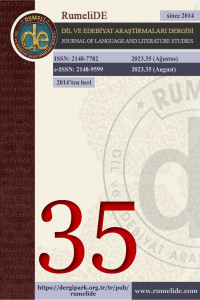The role of surrounding factors in positioning identities: liminality of Dorian Gray in Oscar Wilde’s The Picture of Dorian Gray
Abstract
Masculinity theory, which has been executing its studies as a distinct branch of interest since 1980s, primarily aims to draw attention to the multiplicity of masculinities to undermine the misconception that there is a single, universal, and everlasting concept of masculinity (Sancar, 2009, p. 26), and it also tries to exhibit the fact that masculine identities are always subject to change in relation to surrounding factors such as ideology and historical elements. Similarly, literary masculinity studies aim to foreground the presence of this multiplicity and variety in literary texts, as well as depicting and pointing out the portrayal of non-hegemonic masculine identities who have the potential of constituting alternatives to the hegemonic ones. In accordance with this target, this study aims to investigate Oscar Wilde’s 1890 novel The Picture of Dorian Gray, by concentrating on the fluid identity of its male protagonist with the purpose of exhibiting the fact that even the hegemonic masculinities are subject to change in different contexts. Embodying an alternative masculine identity which is in great contrast with the expectations of hegemonic gender ideology concerning masculinity ideals on one hand, Dorian becomes a hegemonic masculinity model in his own context on the other, which demonstrates the fact that there is not a single and universal type of masculinity, but rather “masculinities” even in the same time interval, culture, and society, and that identities are context-bounded, continuously taking new shapes in relation to surrounding factors.
Keywords
References
- Bell, J. (2006). Decadence, dandyism and aestheticism in the Vampire Chronicles. Journal of the fantastic in the arts, 17 (3), 284-293.
- Belford, Barbara. (1997). On becoming oscar wilde: transformations seen in a biographer’s journal. American imago. 54 (4), 333-345.
- Connell, R.W. (2005). Masculinities. Cambridge: Polity Press.
- Connell, R.W, Jeff H., Michael S. K. (2005). Introduction. Handbook of studies in man and masculinities. London: Sage.
- Edley, N. (2006). Never the twain shall meet: a critical appraisal of the combination of discourse and psychoanalytic theory in studies of men and masculinity. Springer Science+ Business Media. 601-608.
- Hobbs, A. (2013). Masculinity studies and literature. Literature compass. 10 (4), 383-395.
- Horlacher, S. (2011). Constructions of masculinity in British literature from the middleages to the present. New York: Palgrave Macmillan.
- Mallet, P. (2015). The Victorian novel and masculinity. UK: Palgrave Macmillan.
- Mc Carry, M. (2007). Masculinity studies and male violence: critique or collusion? Women’s studies international forum, 30, 404-415.
- Meinhold, R. (2013). The ideal-typical incarnation of fashion: the dandy. A cultural critique. Ed. John I. 111-132
- Reeser, T. W. (2010). Masculinities in theory: an introduction. West Sussex: Wiley& Blackwell.
- Rogers, W., Robert D. W. and Dorothy M. (2004). Aesthetic messenger: oscar wilde lectures in memphis 1882. Tennessee historical quarterly, 63 (4), 249-265.
- Sancar, S. (2009). Erkeklik: imkansız iktidar – ailede, piyasada ve sokakta erkekler. İstanbul: Metis Yayınları.
- Smart, G. and Amelia Y. (2008). “Introduction: Victorian masculinities”. Critical survey. 20 (3), 1-5.
- Sorensen, A. S. (2000). Becomings: studies in boys, men and masculinity. Young. 8 (40), 40-51.
- Sussman, H. (2012). Masculine identities: the history and meaning of manliness. USA: Abc Clio.
- Wilde, O. (1891). Retrieved fom https://www.gutenberg.org/files/174/174-h/174-h.htm
Abstract
References
- Bell, J. (2006). Decadence, dandyism and aestheticism in the Vampire Chronicles. Journal of the fantastic in the arts, 17 (3), 284-293.
- Belford, Barbara. (1997). On becoming oscar wilde: transformations seen in a biographer’s journal. American imago. 54 (4), 333-345.
- Connell, R.W. (2005). Masculinities. Cambridge: Polity Press.
- Connell, R.W, Jeff H., Michael S. K. (2005). Introduction. Handbook of studies in man and masculinities. London: Sage.
- Edley, N. (2006). Never the twain shall meet: a critical appraisal of the combination of discourse and psychoanalytic theory in studies of men and masculinity. Springer Science+ Business Media. 601-608.
- Hobbs, A. (2013). Masculinity studies and literature. Literature compass. 10 (4), 383-395.
- Horlacher, S. (2011). Constructions of masculinity in British literature from the middleages to the present. New York: Palgrave Macmillan.
- Mallet, P. (2015). The Victorian novel and masculinity. UK: Palgrave Macmillan.
- Mc Carry, M. (2007). Masculinity studies and male violence: critique or collusion? Women’s studies international forum, 30, 404-415.
- Meinhold, R. (2013). The ideal-typical incarnation of fashion: the dandy. A cultural critique. Ed. John I. 111-132
- Reeser, T. W. (2010). Masculinities in theory: an introduction. West Sussex: Wiley& Blackwell.
- Rogers, W., Robert D. W. and Dorothy M. (2004). Aesthetic messenger: oscar wilde lectures in memphis 1882. Tennessee historical quarterly, 63 (4), 249-265.
- Sancar, S. (2009). Erkeklik: imkansız iktidar – ailede, piyasada ve sokakta erkekler. İstanbul: Metis Yayınları.
- Smart, G. and Amelia Y. (2008). “Introduction: Victorian masculinities”. Critical survey. 20 (3), 1-5.
- Sorensen, A. S. (2000). Becomings: studies in boys, men and masculinity. Young. 8 (40), 40-51.
- Sussman, H. (2012). Masculine identities: the history and meaning of manliness. USA: Abc Clio.
- Wilde, O. (1891). Retrieved fom https://www.gutenberg.org/files/174/174-h/174-h.htm
Details
| Primary Language | English |
|---|---|
| Subjects | British and Irish Language, Literature and Culture |
| Journal Section | World languages, cultures and litertures |
| Authors | |
| Publication Date | August 21, 2023 |
| Published in Issue | Year 2023 Issue: 35 |

